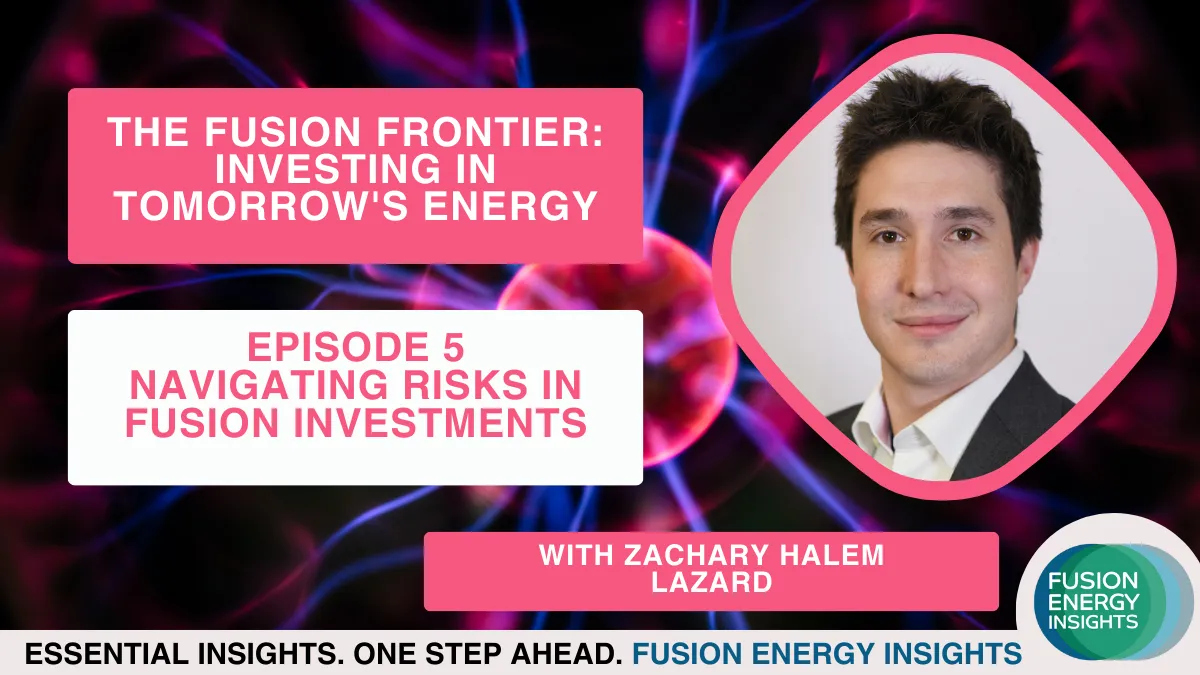Navigating Risks in Fusion Investments with Zachery Halem, Lazard
In our recent podcast series, The Fusion Frontier: Investing in Tomorrow’s Energy, we spoke to experts in fusion energy and investment to dig deeper into the potential of fusion as a clean energy source, why investors invest in fusion, and some of the risks and opportunities along the way.
In Episode 5, we spoke to Zachery Halem, Director of the Climate Center at Lazard, to deep dive into the risks and challenges associated with investing in fusion technology.

Here are 3 key insights from the conversation.
1. Technology risk is the biggest risk for investors in fusion right now
The technology risk of fusion can be broken into two parts:
· Whether the technology can work
· Whether the technology can be economically viable
In terms of economic viability of fusion technology, Zach says that investors are having to examine “even if a technology has a fairly high or a higher probability than others of succeeding, that doesn't say much to its levelised cost and its competitiveness with other energy sources in 15-20 years.” This makes the risk level difficult to navigate but, as Zach says, during his five years of examining the fusion industry investment has grown from $1 billion to over $6 billion – read the Fusion Industry Association report The Global Fusion Industry in 2023 which details this growth further.
The main way that investors can mitigate the technology risk of fusion investment or boost their returns is “through a portfolio approach” says Zach. This means making investments in several different technological approaches to fusion to bet that one of them will succeed, for example inertial confinement and tokamak designs.
Zach says that it is also important for investors to consider return on investment from wider application of the technologies created by fusion companies, for example “improved magnets using high temperature superconducting materials, better materials that can withstand neutron bombardment, better control systems – these all have applications elsewhere and will present revenue possibilities.”
2. “Fusion sits from an investor stand-point in the valley of death”
The ‘valley of death’ is a phrase to refer to investment strategy which is high risk, has a long time period for fruition and return, plus entry to the market requires knowledge to understand the technologies. This is where fusion sits right now.
However, Zach notes that there has been “robust venture capital participation” in fusion so far, meaning the market has reached over $6 billion in value and there are positive developments, such as the NIF fusion energy gain being reached and large players like Commonwealth Fusion Systems showcasing an ability to raise capital and then meet their targets and milestones, which are increasing willingness of investors to look towards fusion.
3. We need (private) capital now to be able to successfully deliver commercial fusion
Zach talks about the importance of public-private partnerships for helping technologies succeed, particularly for energy technologies, as nuclear fission has shown in the past. Public-private partnerships will be important for fusion too. (You can listen to more about public-private partnerships in episode 7 of our podcast.)
But private capital is also needed for fusion, particularly from institutional funds such as sovereign wealth funds and pension funds, but also the continued contribution of venture capital and high net worth individuals.
Zach says: “this industry needs private capital. It needs more private capital in order to get from where we are now to a commercial fusion reactor.”
And finally…
Zach says “a decentralised and independent energy source is universally beneficial. We understand the benefits of fusion pretty well: the amount of energy that can be generated, that its sustainable, that it doesn't have the risks of fission in terms of a run-away reaction, the availability of underlying materials and fuel. But we don't understand what the total costs are … we don't have a full calculation of what the overnight costs are, what the operating costs are, what level of subsidy will be needed …. There's open questions about where fusion will sit in an energy mix, if and when the technology is successful and able to be commercialised.”
